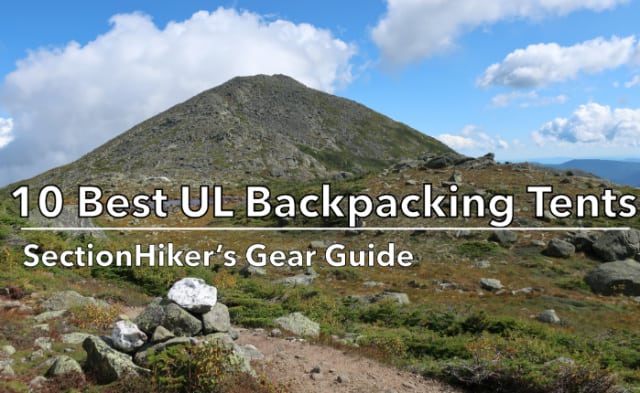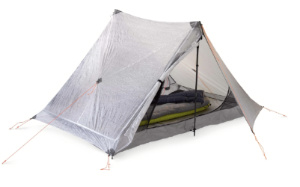
Ultralight backpacking tents are a good option when you’re trying to reduce the weight of your backpacking gear but you’re unwilling to give up the comfort of a tent and sleep under a tarp without insect protection. The lightest weight ultralight backpacking tents are often made with Dyneema Composite Fabrics (DCF) and use trekking poles instead of tent poles to save weight. While many are single-wall tents and more prone to internal condensation, some are double-wall tents or a hybrid combination of the two. But don’t discount tents made with more conventional fabrics that are freestanding, more wind worthy, longer for tall people, or more spacious, especially for couples. There has never been a better time than now to buy a lightweight tent.
Here are the 10 best ultralight backpacking tents that we recommend.
| Make / Model | Type | Material | Min Weight |
|---|---|---|---|
| Zpacks Duplex (1P) | Single Wall | DCF | 18.5 oz / 525g |
| Gossamer Gear "The One" (1P) | Single Wall | Sil/PU Nylon | 17.7 oz / 503g |
| Durston X-Mid 1 | Double Wall | Sil/PeU Poly | 28 oz / 795g |
| NEMO Hornet OSMO Elite 2 (2P) | Double Wall | Poly-Nylon | 27 oz/ 779g |
| Tarptent Double Rainbow Li (2P) | Single Wall | DCF | 26.4 oz / 746g |
| Zpacks Plex Solo (1P) | Single Wall | DCF | 13.9 oz / 395g |
| Six Moon Designs Lunar Solo (1P) | Single Wall | Silpoly | 26 oz / 740g |
| Tarptent Notch Li (1P) | Double Wall | DCF | 19.9 oz / 562g |
| Hyperlite Mtn Gear Unbound 2 (2P) | Single Wall | DCF | 24 oz / 680g |
| Tarptent Dipole Li 2 (2P) | Single Wall | DCF | 26.15 oz / 633 |
See our advice at the bottom of the page for advice about how to choose between these different options.
1. Zpacks Duplex Tent (2P)
2. Gossamer Gear “The One” (1P)
Check out the latest price at:
Gossamer Gear
3. Durston X-Mid 1 (1P)
4. NEMO Hornet Elite OSMO 2 (2P)

| Shop at REI | Shop at Backcountry |
5. Tarptent Double Rainbow (2P)
6. Zpacks Plex Solo (1P)
7. Six Moon Designs Lunar Solo (1P)
8. Tarptent Notch Li (1P)
9. Hyperlite Mountain Gear Unbound 2 (2P)
10. Tarptent Dipole (2P)
Ultralight Backpacking Tent Selection Guide
The backpacking tent manufacturers who make trekking poles tents use a wide range of different materials and designs. When shopping for a tent, it’s important to understand the tradeoffs of the models you’re considering and how they can complement your adventures.
Ultralight Tent Materials and Price Points
Trekking poles tents are available in a variety of different materials and at different price points. Dyneema DCF is the lightest weight material and the most expensive, in part because it requires specialized manufacturing processes. Tents made with Silpoly, Silnylon, and PU coated silnylon are much less expensive than Dyneema because they can be sewn using conventional methods. They’re also roughly comparable in price. It’d be difficult to say which is the best fabric to make tents with because fabric quality varies widely depending on the manufacturer and specification to which it is made. That said, ultralight tentmakers are beginning to switch away from silnylon to silpoly because it has less stretch than silnylon and absorbs less water.
- Tents made with Dyneema DCF are very expensive, but also very lightweight, waterproof, and strong. They are more prone to damage from sunlight over the long term, but that’s seldom an issue for most people. Dyneema tents must be folded when packed not stuffed, but can still be surprisingly bulky despite their low weight.
- Tents made with siliconized polyester (silpoly) are an attractive alternative to Dyneema DCF because they don’t stretch much overnight or when they get wet from rain. They’re also far less expensive and some are seam-taped, so you can use them out of the box without any seam sealing.
- Tents made with PU-coated silnylon are generally more waterproof than regular silnylon, but you need to compare their waterproofing specs to be sure. The chief benefit of the PU coating over regular silnylon is improved UV resistance and the fact that the material can be factory seam-taped.
- Tents made with silnylon are still common because it’s an easy material for manufacturers to work with. While silnylon does stretch at night and when it gets wet, it’s not as big a deal as people make it out to be. Silnylon tents must be manually seam-sealed before they can be used in rainy weather. While you can do this yourself, my advice would be to pay the manufacturer to do it for you so you get a tent that’s ready to be used when it arrives.
Single-wall vs Double-wall Tents
Ultralight backpacking tents are available in single-wall and double-wall models, with separate inner tents. While both are susceptible to internal condensation, the advantage of a double-wall tent is the moisture collects on the underside of the rainfly and not on a wall that has contact with your sleeping bag, quilt, or other gear. The inner tent and rainfly on many double-wall tents can also be used independently from one another, for example as a standalone tarp or as a bug bivy, which can extend their utility. The advantage of a single-wall tent over a double-wall one is usually reduced weight.
If tent condensation ever becomes an issue for you, we recommend carrying a small absorbent face towel to wipe it away. Tent condensation is a small price to pay for reduced gear weight and it won’t kill you unless you’re a witch (wizard-0f-Oz reference).
Headroom
Many ultralight backpacking tents pole tents have a pyramid shape which can limit the amount of headroom and foot room available under the sloping ceiling. Lying on your back and staring at a ceiling that’s three inches from your face can be unpleasantly claustrophobic. Make sure you examine the length of the tents you’re considering, in addition to their peak heights.
Trekking pole tents that require two poles to set up usually have two peaks, which can increase the amount of livable space overhead, compared to a one-pole tent. Some tent manufacturers also reduce the slope of the ceiling to create more headroom. The best example of this is Tarptent’s use of carbon fiber end struts to increase the amount of room under the ceilings at the head and foot ends of their tents. The downside of these end struts is that it can make tents harder to pack horizontally in a backpack.
Vestibules
Vestibules are good for gear storage, especially wet gear storage, and for cooking under cover in windy or rainy weather. Most one-pole tents have a single vestibule, while two-pole tents generally have two. When buying a two-person tent, you’ll definitely want two doors and two vestibules so you can each have your own entrance and gear storage area. It can also be quite useful to have two doors and two vestibules on a one-person tent, especially if you anticipate stormy weather conditions where you might have to hunker down in your tent for a day. For that matter, many people use two-person tents as solo tents, something that’s feasible without a major weight penalty since most ultralight backpacking tents are quite lightweight.
Pole Length
When you choose a trekking pole tent, you want to make sure that it is compatible with the make and model of trekking pole you use if you have a preference. Fixed-length poles that are not adjustable can be difficult to use with trekking pole tents which have very specific height requirements. In addition, you want to make sure that your trekking pole handles are compatible if they have a non-standard grip.
Check Out All of SectionHiker's Gear Guides!
- 10 Best Hiking Shoes and Trail Runners
- 10 Best 2-Person Backpacking Tents
- 10 Best 1-Person Backpacking Tents
- 10 Best Backpacking Stoves
- 10 Best Backpacking Water Filters
- 10 Best Lightweight Backpacks
- 10 Best Ultralight Backpacks
- 10 Best Backpacking Sleeping Bags
- 10 Best Ultralight Backpacking Quilts
- 10 Best Lightweight Backpacking Chairs
- 10 Best Backpacking Sleeping Pads
- 10 Best Backpacking Rain Jackets
- 10 Best Hiking Daypacks
- 10 Best Hiking Pants
- 10 Best Trekking Poles
 SectionHiker.com Backpacking Gear Reviews and FAQs
SectionHiker.com Backpacking Gear Reviews and FAQs 








The last year’s version of the REI Flash Air 2 is also a good lightweight tent at a little over 2lbs, and it’s currently on closeout for 50% off. Looks like the new version of the Flash Air 2 is several ounces heaver, and currently $399.
Hey Phil,
I have been really struggling to decide between mostly the double rainbow li and the dipole 2 li, any chance you have a review coming out for the dipole 2?
It won’t be for a while. I’ve got a few tents to review before it and it’s still deep winter here. Tarptent has a video of the Dipole on their site, which is a first look from Ryan Jordan. Check that out. What I like about the Dipole is the fact that Tarptent made the corner struts collapsible so they’ll fit horizontally in most packs. That’s in direct response to a review I did on one of their tents a few years back. The rainbow Li is really nice, but carrying an extra pole in addition to my trekking poles doesn’t really appeal to me.
Tarptent Aeon Li is simply missing…
The Dipole kicked it off last year’s list. One of the problems with the Aeon Li, which is quite nice though snug, has to do with packing its pitchlocs (corner struts). They’re too long to fit horizontally in many lightweight and ultralight packs. Tarptent fixed that problem in the Dipole so they are collapsible. Given the dual vestibules on the Dipole, there really is no comparison to the Aeon Li, which only has one.
Thank you for the explanation!
I have a question, I am interested in the altaplex because it is a little bigger than the plex solo. You said it has a little more length and on the website it says that they are both 7.5 long. I realize it is taller and wider but are they the same length? I am using a lunar solo and like the tent but want to try dyneema out and would like something a little longer.
If that’s what Zpacks has in their specs, then they’re the same. I thought the Altaplex was longer, but maybe they changed it.
I’m trying to decide between the Dipole 1, and X-Mid 1. Both in Sil-Poly. The Dipole seems to have more “things” vs. the simpler X-Mid, but also some benefits. Do you have a preference? Thanks!
I’m currently testing a Dipole DW 1 and don’t have any well formed opinions yet – though I will soon. That said, the X-mid is simpler to pitch. Not by that much, but by some, while the Dipole has much better internal pockets (4) and more living space.